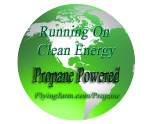

|
So maintain your supply & always,
Dual Fuel, Keep Your Options Open
Made in the USA.
The
following is information from the
Propane, the most common liquefied petroleum gas (LP-gas), is one of
the
nation's most versatile sources of energy and supplies about 4
percent of our
total energy needs.
Propane exists as a liquid and a gas. At atmospheric pressure and
temperatures
above –44 F, it is a non-toxic, colorless and odorless gas. Just as
with natural
gas, an identifying odor is added so it can be readily detected.
When contained in
an approved cylinder or tank, propane exists as a liquid and vapor.
The vapor is
released from the container as a clean-burning fuel gas. Propane is
270 times
more compact as a liquid than as a gas, making it economical to
store and
transport as a liquid.
Approximately 90 percent of the United States’ propane supply is
produced
domestically, while 70 percent of the remaining supply is imported
from Canada
and Mexico. Approximately equal amounts of propane come from the
refining of
crude oil and from natural gas processing. Thus, propane is a
readily available,
secure energy source whose environmental benefits are widely
recognized.
Propane is an approved, alternative clean fuel listed in the 1990
Clean Air Act, as well as the National Energy Policy Act of 1992.
Uses
ON THE FARM
Propane is a staple on 660,000 farms, where it is used in a wide
range of agricultural applications:
Crop drying—corn, soybeans, grains, tobacco, apples, peanuts, onions
and other crops.
Flame cultivation—controlling weed growth using propane burners.
Fruit ripening.
Space heating—for barns, pig farrowing houses, chicken houses, stock
tanks,
nurseries, greenhouses, orchards, and incubators.
Water heating—for dairies and stock watering tanks.
Refrigeration of foods.
Running a variety of farm engines, including tractors, weed
eaters,
irrigation
pumps, stand-by generators, and seedling planters.
A bit of
HISTORY on PROPANE
• Propane gas is nontoxic, so it’s not harmful to soil and water.
Because propane does not endanger the environment, the placement of
propane tanks either above or below ground is not regulated by the
Environmental Protection Agency.
Copyright 1999-20014 Flyingfarm.com All rights reserved |


